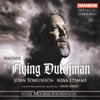Wagner (The) Flyng Dutchman
A ha’porth of dramatic tar would have sealed the success of this Dutchman’s ship
View record and artist detailsRecord and Artist Details
Composer or Director: Richard Wagner
Genre:
Opera
Label: Opera in English Series
Magazine Review Date: 1/2005
Media Format: CD or Download
Media Runtime: 142
Mastering:
Stereo
DDD
Catalogue Number: CHAN3119

Tracks:
| Composition | Artist Credit |
|---|---|
| (Der) Fliegende Holländer, '(The) Flying Dutchman' |
Richard Wagner, Composer
David Parry, Conductor Eric Halfvarson, Daland, Bass Geoffrey Mitchell Choir John Tomlinson, Holländer, Baritone Kim Begley, Erik, Tenor London Philharmonic Orchestra Nina Stemme, Senta, Soprano Patricia Bardon, Mary, Contralto (Female alto) Peter Wedd, Steersman, Tenor Richard Wagner, Composer |
Author: Arnold Whittall
For many years, ‘Wagner in English’ has meant the English National Opera’s Ring cycle, recorded in the 1970s and now available as part of this Chandos series. Even those with reservations about Reginald Goodall’s conducting will concede that he nurtured an outstanding group of singers, led by Norman Bailey, Rita Hunter and Alberto Remedios, and that the strengths of the cycle are very much to do with the special tensions and inspirations of live performance. So how does this new studio recording of The Flying Dutchman stand up to the comparison?
Certain spatial effects, as in the contrasting placements of the Norwegian sailors and the Dutchman’s crew in Scene 3, are effectively suggested: but actual sound-effects – like the stamping feet in the Scene 3 dance, specified by Wagner – are shunned. Such a minor detail is hardly decisive, but it confirms one’s suspicion that the conductor’s overall vision of the piece’s steadily accumulating pace and momentum – especially in the one-act version used here – is difficult if not impossible to realise adequately under studio conditions. As with the recent Masked Ball, also conducted by David Parry (11/04), one misses the thrills and spills of an evening in the theatre. Nevertheless, a certain lack of dramatic immediacy is as much the result of the acoustic as of the recording process. This is spacious to a fault, so if you like singers and orchestra kept at a certain distance, you’ll be especially happy. But even if you don’t, these singers make an excellent team.
It’s now more than a decade since John Tomlinson’s distinguished Wotan for Daniel Barenboim’s Bayreuth Ring, and although his voice is less supple than it was, he still sings with huge authority. Alongside this formidable Dutchman, the Swedish soprano Nina Stemme – Glyndebourne’s Isolde in 2003 – is the ideal Senta, her voice sensitive and secure across the entire range: and with Kim Begley an ardent, unwimpish Erik these three principals do much to counter reservations about this or that choice of tempo (in parts of the big Scene 2 duet, for example), or about under-characterised orchestral details.
The new translation is by Christopher Cowell: there’s nothing about him in the booklet, or about Henrietta Bredin, credited with ‘translation research’, but the task has been approached with considerable flair, despite the occasional, inevitable banalities, and the words come across clearly and positively. Would a recording of an ENO stage performance, using David Pountney’s translation, have been preferable? The overall experience would almost certainly have been more genuinely theatrical: but with a cast as excellent as this one, it’s difficult to spend too much time contemplating alternatives.
Certain spatial effects, as in the contrasting placements of the Norwegian sailors and the Dutchman’s crew in Scene 3, are effectively suggested: but actual sound-effects – like the stamping feet in the Scene 3 dance, specified by Wagner – are shunned. Such a minor detail is hardly decisive, but it confirms one’s suspicion that the conductor’s overall vision of the piece’s steadily accumulating pace and momentum – especially in the one-act version used here – is difficult if not impossible to realise adequately under studio conditions. As with the recent Masked Ball, also conducted by David Parry (11/04), one misses the thrills and spills of an evening in the theatre. Nevertheless, a certain lack of dramatic immediacy is as much the result of the acoustic as of the recording process. This is spacious to a fault, so if you like singers and orchestra kept at a certain distance, you’ll be especially happy. But even if you don’t, these singers make an excellent team.
It’s now more than a decade since John Tomlinson’s distinguished Wotan for Daniel Barenboim’s Bayreuth Ring, and although his voice is less supple than it was, he still sings with huge authority. Alongside this formidable Dutchman, the Swedish soprano Nina Stemme – Glyndebourne’s Isolde in 2003 – is the ideal Senta, her voice sensitive and secure across the entire range: and with Kim Begley an ardent, unwimpish Erik these three principals do much to counter reservations about this or that choice of tempo (in parts of the big Scene 2 duet, for example), or about under-characterised orchestral details.
The new translation is by Christopher Cowell: there’s nothing about him in the booklet, or about Henrietta Bredin, credited with ‘translation research’, but the task has been approached with considerable flair, despite the occasional, inevitable banalities, and the words come across clearly and positively. Would a recording of an ENO stage performance, using David Pountney’s translation, have been preferable? The overall experience would almost certainly have been more genuinely theatrical: but with a cast as excellent as this one, it’s difficult to spend too much time contemplating alternatives.
Discover the world's largest classical music catalogue with Presto Music.

Gramophone Digital Club
- Digital Edition
- Digital Archive
- Reviews Database
- Full website access
From £8.75 / month
Subscribe
Gramophone Full Club
- Print Edition
- Digital Edition
- Digital Archive
- Reviews Database
- Full website access
From £11.00 / month
Subscribe
If you are a library, university or other organisation that would be interested in an institutional subscription to Gramophone please click here for further information.




